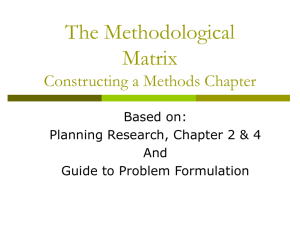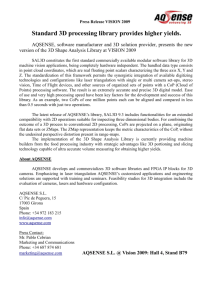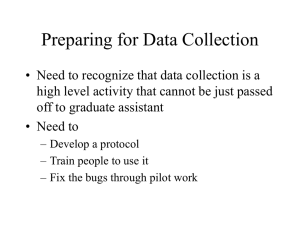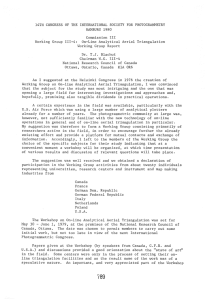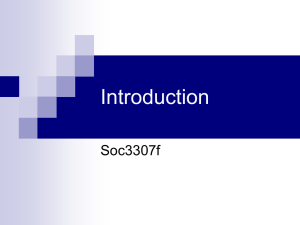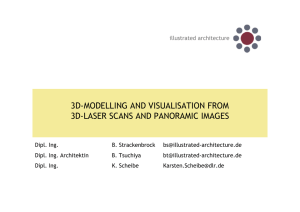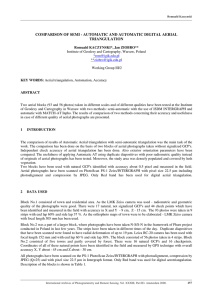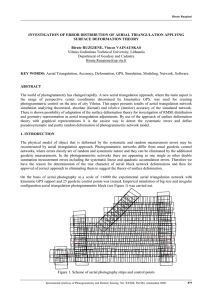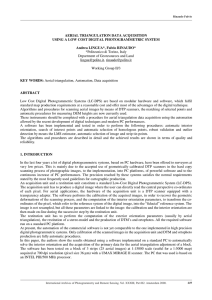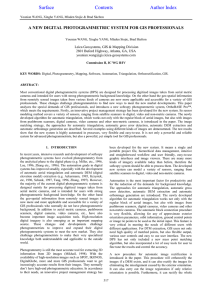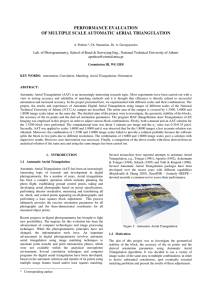STATISTICAL DATA ON AERIAL TRIANGULATION
advertisement
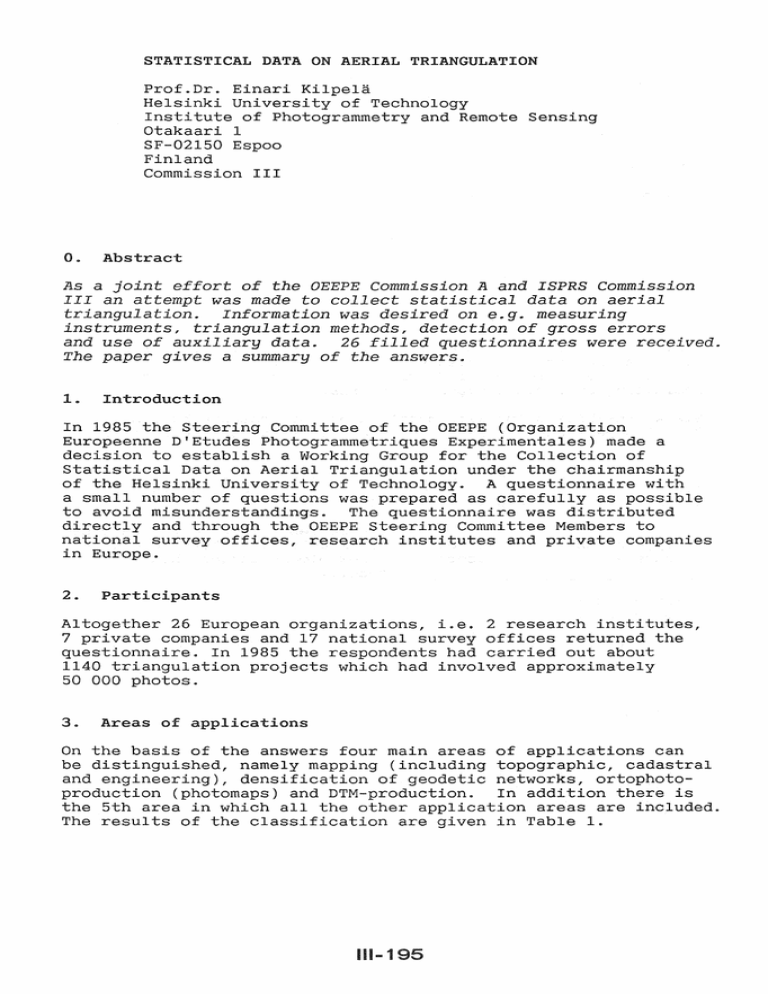
STATISTICAL DATA ON AERIAL TRIANGULATION
Prof.Dr. Einari Kilpela
Helsinki University of Technology
Institute of Photogrammetry and Remote Sensing
Otakaari 1
SF-02150 Espoo
Finland
Commission III
0..
Abstract
As a joint effort of the OEEPE Commission A and ISPRS Commission
III an attempt was made to collect statistical data on aerial
triangulation.
Information was desired on e.g. measuring
instruments, triangulation methods, detection of gross errors
and use of auxiliary data..
26 filled questionnaires were received.
The paper gives a summary of the answers.
1.
Introduction
In 1985 the Steering Committee of the OEEPE (Organization
Europeenne D'Etudes Photogrammetriques Experimentales) made a
decision to establish a Working Group for the Collection of
Statistical Data on Aerial Triangulation under the chairmanship
of the Helsinki University of Technology. A questionnaire with
a small number of questions was prepared as carefully as possible
to avoid misunderstandings.
The questionnaire was distributed
directly and through the OEEPE Steering Committee Members to
national survey offices, research institutes and private companies
in Europe.
2.
Participants
Altogether 26 European organizations, i.e. 2 research institutes,
7 private companies and 17 national survey offices returned the
questionnaire. In 1985 the respondents had carried out about
1140 triangulation projects which had involved approximately
50 000 photos.
3.
Areas of applications
On the basis of the answers four main areas of applications can
be distinguished, namely mapping (including topographic, cadastral
and engineering), densification of geodetic networks, ortophotoproduction (photomaps) and DTM-production.
In addition there is
the 5th area in which all the other application areas are included.
The results of the classification are given in Table 1.
IU . . 1
Application
Percentage of
respondents
[%]
Densification
Mapping
Ortophoto
DTM
Other
Percentage of
all projects
[%]
11
96
3
83
15
7
7
2
15
5
Table 1. Areas of the applications and their
percentages of all projects.
4.
Project parameters
4.1 Aerial photography
A distinct majority of the participants used Zeiss RMK or Wild
RC 10 cameras for photography (11 and 9 users, respectively).
As can be seen from Table 2, wide angle cameras were clearly
dominating over other types of cameras.
Black-and-white films were mostly used for photography (Table
3). Two participants had used color films and one color-infrared
films.
The scale of photography ranged from 1:2 500 to 1:80 000, but in
most cases it was from 1:4 000 to 1:13 000.
Several overlapping
combinations were applied (Table 4).
Type of the
camera
The largest block contained over
700 models, but there were only
a few blocks larger than 100
models.
No. of
users
Narrow angle
Normal angle
Wide angle
Super-wide angle
Type of film
Agfa Aviophot Pan 150
Agfa Aviophot Pan 200
Kodak Plus-X
Kodak Double-X
4
2
15
2
Table 2. Types of cameras used.
No. of
users
4
7
4
4
111-196
Table 3. Films mostly used.
Side
10
Forward
55
20
25
55 60
60 65
30
35
40
60
60 65 90
60
60
60 80 90
A
B
1
1
5
2
1
2
1
2
6
2
1
C
1
D
TOTAL
1
1
6
11
1
1
4
1
1
5
1
1
2
1
1
1
2
1
1
Table 4. Number of users of the different combinations of the
forward and side overlaps.
A
B
=
=
Network densification
Mapping
C = Ortophoto-production
D = DTM-production
5. Control and tie points and their targetting
The material available does not make possible any deeper analysis
of the control point configurations. Perimeter control in
planimetry seemed to be widely used anyway. Nearly 50% of the
users applied it. Control distribution in height was commonly
irregular.
In nearly all the blocks at least some control points were
targetted.
The square target was clearly the most popular one
(Table 5).
Shape
Square
Circle
Cross
Triangle
No. of
users
Size [pm]
13
3
3
1
20 - 120 1)
24 - 60 2)
Table 5. Use of different
kinds of targets.
1) most often 50-70 pm
2) diameter
The number of tie-points between the computational units (photos
or models) was typically 3-6 in the flight direction and 2-4 in
the perpendicular direction.
Information on the use of the
different types of tie-points are given in Table 6.
111-197
No. of users of different tie-point targets
Application
Targetted
Natural
3
7
1
1
2
12
Network densif.
Mapping
Ortophoto
DTM
Table
6.
2
1
Artificial
1
13
3
1
Numerical
1
6. Use of the different types of tie-points.
Mensuration
The number of the users of different types of measuring instruments
is presented in Table 7. 13 repondents reported that the measuring
process is controlled on-line.
Measuring instr.
Analog instrument
Monocomparator
Stereocomparator
Analytical plotter
7.
No. of
users
12
2
7
20
Table 7. Use of different
measuring instruments.
Triangulation method
Triangulation methods were divided into analog, semianalytical
and analytical methods depending on whether the measured data
were strip, model or image coordinates, respectively. Analytical
methods were further divided into
sequential, model or bundle method
Triang .. method
No .. of
depending on whether the compuusers
tational unit in the block adjustment
was strip, model or image, respectively. Table 8 shows, how
Analog
many users different methods had.
1
Semianalytical
3
- 2D
3
- 3D
Analytical
1
- Sequential
Table 8. Number of users of
18
- Model
different triangulation methods.
8
- Bundle
111 . . 198
8.
Compensation of systematic and gross errors
The compensation of systematic errors was mainly based on component
calibration. 8 respondents, however, reported having used selfcalibration. Nobody had used test-field calibration.
Approximately 40% of the respondents had applied algorithmic
methods for the gross error detection.
Statistical methods
(e.g. data snooping) had 8 users and robust methods (e.g. the
Danish method) 2 users. The estimates for the number of gross
errors in the data varied from 0.3% to 10%.
9.
Use of auxiliary data
Only a few respondents had exploited auxiliary data (Table 9).
Auxiliary data
No. of
users
APR-data
Navigation data
Geodetic data
Shoreline data
10.
1
1
5
4
Table 9. Number of users of the
different types of auxiliary data.
Accuracy of aerial triangulation
The accuracy information received was unfortunately rather
scarce and there were in addition some interpretation difficulties.
Therefore, any analysis was considered unfeasible and only some
reported values are given as such in Tables 10 and 11.
RMSE 2 )
St.errors
Organization
~ 1)
0
lxy
1
2
3
3
10
~z
2
jlxy
4
7
7
4
6
7
7
5
3-5
20
jlz
50
1) Standard error of unit weight.
2) Root mean square error.
Table 10. Accuracy information on bundle adjustments
(at photo scale [pm]).
111 ... 199
RMSE 2 )
st. errors
Organization
6 1)
0
1
2
3
4
5
6
7
8
9
10
11
12
13
14
15
16
17
18
18
4-5
30
10
18
10/13
10/20-35
8-17/12-17
8-10
8-10
6
20
7
10
8-13/10-17
3-9/10-15
7/13
11/13
lxy
6
13
11
z
30
5
13
9
10
27
8
10
8
10-20
8
16
6
20
7
8-10
8-11
3-8
10
30
10
12-15
6-10
6-10
f"XY
fz
13
7
10
20
5-9
7-14
3-10
3-4
6-10
2-8
1) Standard error of unit weight.
The values separated by a bar
refer to planimetry and height, respectively.
2) Root mean square error at check points.
Table 11. Accuracy information on analytical (image coordinates
measured) triangulation by independent models (at photo scale
[{lm] ) •
11. Acknowledgement
Thanks are given to those national survey officies,private
companies and research institutes which returned the filled
questionnaires.
The author owes very special thanks to
Mr. Keijo Inkila who helped in compiling the tables for the
article.
111 ... 200
